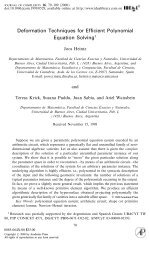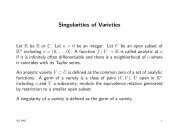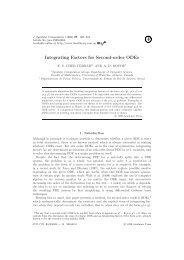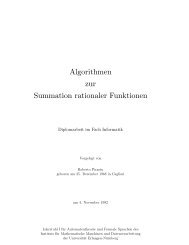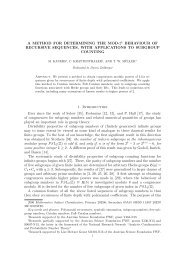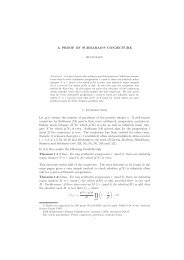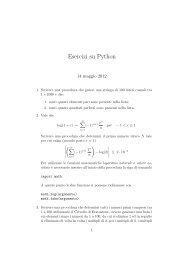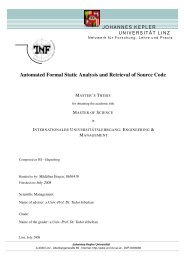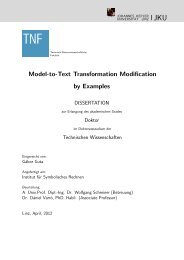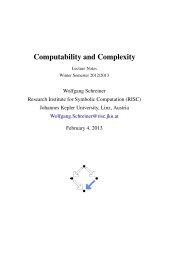Chapter 7 Local properties of plane algebraic curves - RISC
Chapter 7 Local properties of plane algebraic curves - RISC
Chapter 7 Local properties of plane algebraic curves - RISC
You also want an ePaper? Increase the reach of your titles
YUMPU automatically turns print PDFs into web optimized ePapers that Google loves.
So the tangent to F at P is defined by<br />
√<br />
2(x −<br />
1 √2 ) + √ 2(y − 1 √<br />
2<br />
) = 0 ∼ x + y − √ 2 = 0.<br />
D has a node at the origin. E has an ordinary 3–fold point at the origin. C and F both<br />
have a non–ordinary singular point at the origin.<br />
Lemma 7.1.1. Let C be an affine <strong>plane</strong> curve defined by the squarefree polynomial<br />
f = ∏ n<br />
i=1 f i where all the components f i are irreducible. Let P be a point in A 2 (K).<br />
Then the following holds:<br />
(1) mult P (C) = ∑ n<br />
i=1 mult P(C i ), where C i is the component <strong>of</strong> C defined by f i .<br />
(2) If L is a tangent to C i at P with multiplicity s i , then L is a tangent to C at P<br />
with multiplicity ∑ n<br />
i=1 s i.<br />
Pro<strong>of</strong>.<br />
(1) By the remark above we may assume that P is the origin. Let<br />
f i (x, y) =<br />
∑n i<br />
j=s i<br />
g i,j (x, y) for i = 1, . . .,n,<br />
where n i is the degree <strong>of</strong> C i , s i =mult P (C i ), and g i,j is the homogeneous component<br />
<strong>of</strong> f i <strong>of</strong> degree j. Then the lowest degree homogeneous component <strong>of</strong> f is ∏ n<br />
i=1 g i,s i<br />
.<br />
Hence, (1) follows from Remark (3).<br />
(2) follows directly from Remark (4) and from the expression <strong>of</strong> the lowest degree<br />
homogeneous component <strong>of</strong> f deduced in the pro<strong>of</strong> <strong>of</strong> statement (1).<br />
Example 7.1.3. Determine the singular points and the tangents at these singular<br />
points to the following <strong>curves</strong>:<br />
(a) f 1 = y 3 − y 2 + x 3 − x 2 + 3y 2 x + 3x 2 y + 2xy,<br />
(b) f 2 = x 4 + y 4 − x 2 y 2 ,<br />
(c) f 3 = x 3 + y 3 − 3x 2 − 3y 2 + 3xy + 1,<br />
(d) f 4 = y 2 + (x 2 − 5)(4x 4 − 20x 2 + 25).<br />
Plot the real components (i.e. in A 2 (R)) <strong>of</strong> these <strong>curves</strong>.<br />
Theorem 7.1.2. An affine <strong>plane</strong> curve has only finitely many singular points.<br />
Pro<strong>of</strong>: Let C be an affine <strong>plane</strong> curve with defining polynomial f, let f = f 1 · · ·f r<br />
be the irreducible factorization <strong>of</strong> f, and let C i be the component generated by f i<br />
(note that f is squarefree, so the f i ’s are pairwise relatively prime). Then, applying<br />
89



